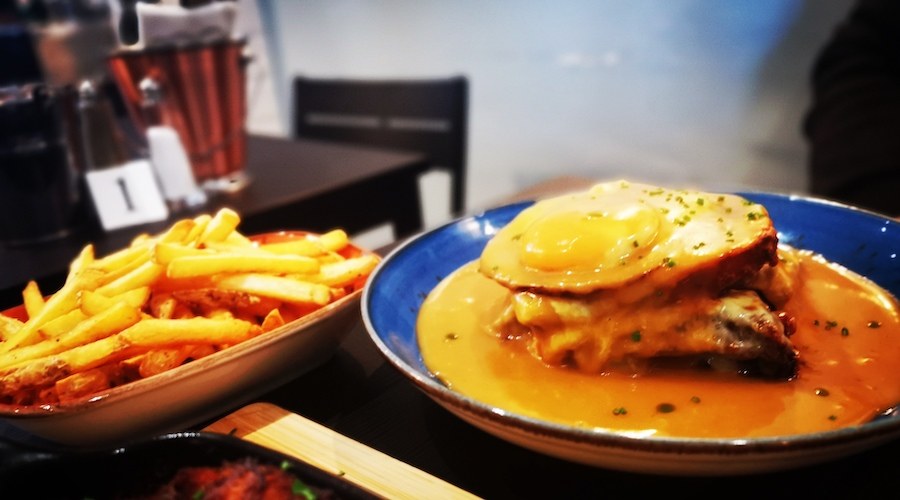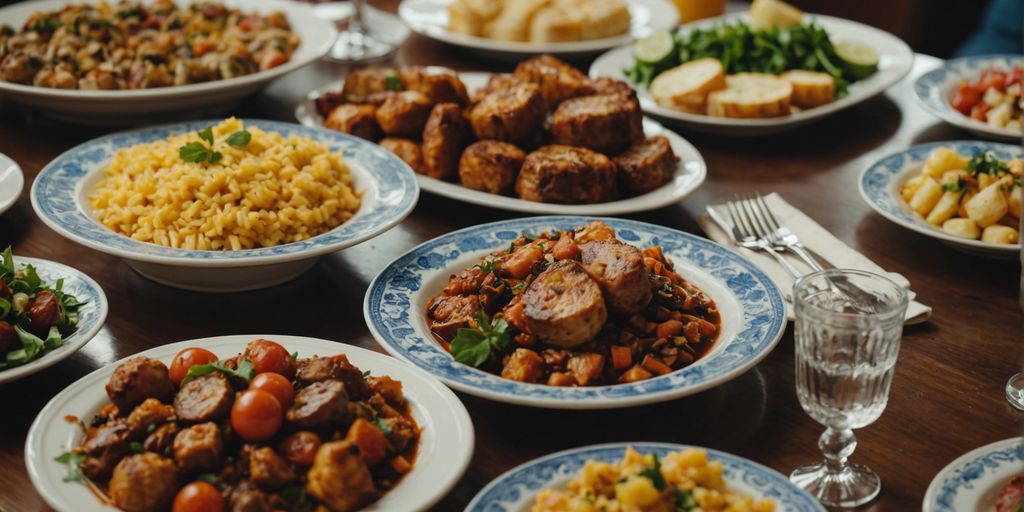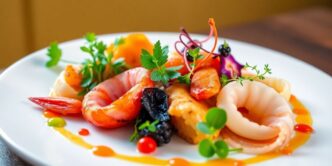Bacalhau: The King of Portuguese Cuisine
Bacalhau is a key part of Portuguese culinary heritage. It’s often present at social gatherings and, in some parts of Portugal, it’s served as part of the traditional Christmas Eve meal. Bacalhau can be baked as a filet or in casseroles, grilled, found swimming in rice, or shredded with scrambled eggs, onions, and fried potatoes.
Bacalhau à Brás: A Classic Twist
Bacalhau à Brás is one of the most famous Portuguese dishes and deservedly so! This mixture of shredded codfish and fried potato sticks, olive oil, eggs, onions, and parsley is very easy to prepare, but you can also find it in most Portuguese restaurants.
Bacalhau com Natas: Creamy Delight
Bacalhau com Natas is a creamy, comforting dish. It features cod baked with cream and cheese, creating a rich and satisfying meal. Perfect for a cozy dinner.
Grilled Bacalhau: Simple and Delicious
Grilled Bacalhau is a simple yet delicious way to enjoy this fish. Just grill the cod with some olive oil and garlic, and you have a tasty, healthy meal. Great for summer barbecues.

Francesinha: Porto’s Hearty Sandwich
Feeling really, really hungry? Head to Porto for the sandwich to end all sandwiches, the francesinha. Even calling it a sandwich doesn’t do it justice. This epic meal is made with two slices of bread, ham, sausage, steak, and linguiça (cured pork sausage). Then, it’s smothered in melted cheese and a slightly spicy tomato and beer sauce.
Caldo Verde: Comfort in a Bowl
Caldo Verde is a beloved Portuguese soup. It’s a simple yet hearty dish that warms the soul. Originating from the Minho region, it dates back to the 15th century. This soup is a staple in Portuguese cuisine and is often enjoyed during celebrations.
Traditional Ingredients
The main ingredients are potatoes, kale, and chorizo. The potatoes and onions are cooked and then blended to create a smooth base. Thinly sliced kale is added for its vibrant color and texture. Finally, slices of savory chorizo are mixed in, making each spoonful a delight.
Modern Takes on Caldo Verde
While the traditional recipe is cherished, modern versions have emerged. Some people add different leafy greens like collard greens. Others experiment with various types of sausage. These twists keep the dish exciting while preserving its comforting essence.
Perfect Occasions to Enjoy Caldo Verde
Caldo Verde is perfect for colder days. It’s also a hit at gatherings like birthdays and weddings. This soup brings people together, making any event special. So, next time you’re hosting, consider serving this classic dish.
Sardinhas Assadas: Grilled Sardines
Sardinhas assadas are a simple yet comforting dish of freshly grilled sardines. Originating in the Lisbon and Vale do Tejo regions, these sardines are roasted whole over an open fire and seasoned with coarse sea salt. It’s a popular summertime festival food in Portugal, best enjoyed from June till August.
Pastéis de Nata: The Iconic Egg Tart
Pastéis de nata are Portugal’s sweet obsession. These creamy custard tarts are a national favorite and have become a global sensation. Originating from the Jerónimos Monastery, they have a rich history and an even richer taste.
History of Pastéis de Nata
The story of pastéis de nata begins in the 17th century. Monks at the Jerónimos Monastery in Lisbon created these tarts. They had extra egg yolks from using egg whites to starch clothes. So, they made these delicious pastries.
Best Bakeries for Pastéis de Nata
You can find these tarts all over Portugal, but some places stand out:
- Pastéis de Belém in Lisbon: Known for their ultra-crisp crust.
- Manteigaria: Another top spot for these treats.
How to Eat Pastéis de Nata Like a Local
Enjoying pastéis de nata is an art. Follow these steps:
- Eat them warm, fresh out of the oven.
- Sprinkle a bit of cinnamon or powdered sugar on top.
- Pair with a strong espresso (ask for a bica if you’re in Lisbon) for the perfect combo.
Alheira: The Unique Sausage
Alheira is a special Portuguese sausage with a fascinating history. It was created by Portuguese Jews to avoid suspicion during the Inquisition. They used meats like chicken, duck, and rabbit instead of pork. Bread was added for texture. Today, you can find alheira served with fried potatoes and a fried egg. It’s also a versatile ingredient in appetizers and pastries.
Tripas à Moda do Porto: A Taste of Tradition
Tripas à Moda do Porto is a dish that tells a story of generosity. Legend has it that when Henry the Navigator was preparing his ships to conquer Ceuta in 1415, he asked the people of Porto to donate supplies. They gave so much that they were left with little more than tripe. From this, they created the recipe for Tripas à Moda do Porto, earning the nickname tripeiros or “tripe eaters.”
Arroz de Marisco: Seafood Rice
Arroz de Marisco is a beloved dish in Portugal. It’s a soupy rice loaded with fresh seafood. Locals can’t get enough of it. Imagine a slightly soupier version of risotto, but packed with ocean goodness like prawns, mussels, and squid. This dish is a must-try for any seafood lover.
Key Ingredients for Arroz de Marisco
The main ingredients include a variety of seafood such as prawns, mussels, and squid. You’ll also find veggies like peas, peppers, and onions. The broth is fragrant and rich, making every bite a delight.
Cooking Techniques
- Start by sautéing onions, garlic, and peppers.
- Add the seafood and cook until just done.
- Pour in the rice and broth, letting it simmer until the rice is tender.
- Season with salt, pepper, and a touch of saffron for color.
Top Spots to Enjoy Arroz de Marisco
- Mar à Vista, Ericeira: Known for its stunning sea views and delicious seafood rice.
- Praia da Vieira, Marinha Grande: Believed to be the origin of this dish, offering a traditional experience.
- Local Taverns: Sometimes the best Arroz de Marisco can be found in small, local spots where the recipe has been passed down for generations.
Polvo à Lagareiro: Octopus Done Right
Polvo à Lagareiro is a must-try Portuguese dish. It’s all about octopus drizzled with olive oil and served with potatoes. The name comes from the workers in olive presses, called lagareiros. They use a lot of olive oil, and it makes this dish super tasty.
Bifana: The Portuguese Pork Sandwich
At first glance, the bifana might seem like just another sandwich. But don’t be fooled! This is Portugal’s best sandwich. It features a light, crusty bread roll filled with juicy, well-seasoned pork strips. The pork is slightly greasy, making it a popular late-night snack. Pair it with a Super Bock for a complete local experience!
What Sets Bifana Apart
Traditional bifana sandwiches are made with pork, garlic, paprika, and white wine. However, many restaurants add their own twist. You might find extras like tomatoes, bell peppers, onions, cheese, or even a fried egg.
Best Places to Grab a Bifana
You can enjoy bifana anywhere in Portugal, but many locals say the best comes from Lisbon. It’s believed to have originated in Vendas Novas, a small town in the Alentejo region. Even McDonald’s in Portugal serves a version called the McBifana!
Pairing Bifana with Drinks
For the best experience, pair your bifana with a local beer like Super Bock. The combination of the juicy pork and the refreshing beer is unbeatable.
Feijoada: A Hearty Bean Stew
Feijoada is a hearty bean stew that’s a staple in Portuguese cuisine. It’s a comforting bowl of goodness, perfect for any occasion.
Açorda: Bread Soup with a Twist
Açorda is a unique Portuguese dish that turns stale bread into a gourmet experience. The name comes from the Arabic word for “bread soup.” There are two main types: Lisbon açorda and Alentejo açorda. Lisbon açorda is made with papo seco bread, water or broth, garlic, and cilantro. Alentejo açorda uses slices of traditional Alentejo bread, olive oil, boiling water, garlic, poached eggs, and lots of coriander or pennyroyal.
Traditional Açorda Recipes
Açorda de marisco uses leftover stale bread and seafood. It’s a simple yet delicious dish. Another popular version is Açorda Alentejana, which is not cooked but made by combining bread with olive oil, boiling water, garlic, and herbs.
Modern Variations of Açorda
Modern takes on açorda include adding different types of seafood or even meat. Some chefs experiment with various herbs and spices to give it a new twist. You can also find vegetarian versions that use vegetable broth instead of seafood or meat.
Best Places to Try Açorda
If you’re in Lisbon, head to Solar dos Presuntos for an unforgettable dining experience. In Tavira, “Come na Gaveta: A Culinary Symphony in Tavira” offers a gastronomic journey celebrating Portuguese cuisine. Márcio Gonçalves and Débora Amaro lead a dedicated team for an unforgettable dining experience.
Frequently Asked Questions
What is Bacalhau and why is it so popular in Portugal?
Bacalhau is dried and salted codfish. It’s a staple in Portuguese cuisine, often called the king of Portuguese dishes. There are many ways to prepare it, making it a versatile and beloved ingredient.
Where can I find the best Francesinha in Porto?
The best Francesinha can be found in several restaurants in Porto, but Café Santiago and Bufete Fase are often recommended by locals and tourists alike.
What are the key ingredients in Caldo Verde?
Caldo Verde is a traditional Portuguese soup made with potatoes, kale, and chouriço (a type of sausage). It’s simple but very flavorful.
How do you grill sardines perfectly?
To grill sardines perfectly, you need to season them with salt and grill them over hot coals until the skin is crispy. It’s important not to overcook them to keep the meat tender.
What is the history behind Pastéis de Nata?
Pastéis de Nata are Portuguese egg tarts that originated in the 18th century. They were created by monks at the Jerónimos Monastery in Lisbon, who used leftover egg yolks to make these sweet treats.
What makes Alheira different from other sausages?
Alheira is unique because it was originally made by Jewish people in Portugal who used bread instead of pork. Today, it includes a mix of meats and is known for its distinct flavor.
How is Tripas à Moda do Porto traditionally cooked?
Tripas à Moda do Porto is a traditional tripe dish cooked with white beans, sausage, and various meats. It’s slow-cooked to blend all the flavors together.
What are the best times to enjoy Feijoada?
Feijoada, a hearty bean stew, is best enjoyed during colder months or at family gatherings. It’s a comforting dish that’s perfect for sharing.












